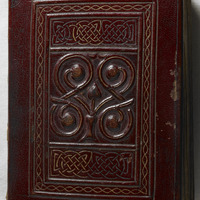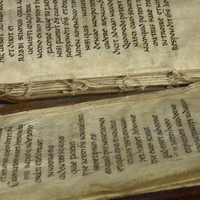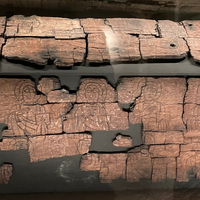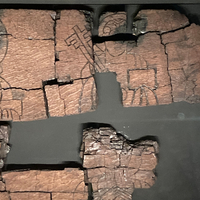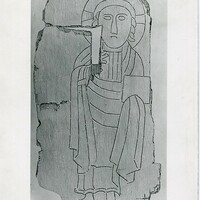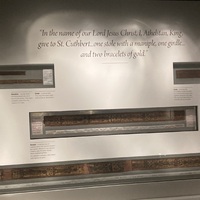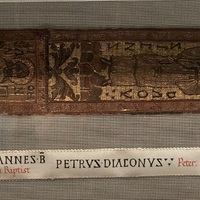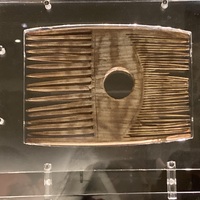Relics and coffin of St. Cuthbert
Date:
Objects ranging from the seventh to tenth century
Location or Findspot (Modern-Day Country):
United Kingdom
Description:
In 698, eleven years after the death of Cuthbert (ca. 635–687), the body of this saintly abbot and bishop of Lindisfarne was translated to a more prominent location in the Lindisfarne monastery's main church. His body and personal possessions were transferred to a wooden coffin carved with the standing figure of Christ, winged evangelist symbols, the Virgin and Child, the twelve apostles, and seven archangels.
Repeated Viking attacks on Lindisfarne began in 793. In 875, the remaining monks fled, taking their patron saint's coffin with them. After several relocations, they eventually settled in Durham in 995. The cathedral still houses Cuthbert's remains, wooden coffin, and relics.
In the tenth century, King Æthelstan (r. 924–927) opened the coffin to add ceremonial textiles—a stole (liturgical scarf), belt, and maniple—as gifts. When the coffin was opened in again 1104 so that Cuthbert's relics could be translated to a new shrine, Cuthbert was found to have been buried with several items including a gold and garnet pectoral cross, a portable altar, an ivory comb, and a personal copy of the Gospel of John. The small book is especially remarkable because it still has its original early eighth-century tooled goatskin cover.
Cuthbert's textiles belong to the class of clothing known as vestments, official costumes that express the status of clerics and highlight their specific actions in religious rituals. Made of colored silk and silk thread wrapped with pure gold, the maniple, a narrow strip worn on the left forearm of a priest or deacon (initially used as a handkerchief to maintain proper cleanliness while performing the Eucharist), is embroidered with the Hand of God and haloed figures of two saints, two popes, and two deacons, each standing about 13 centimeters high. Among them are St. Gregory and his deacon, Peter, who were responsible for sending St. Augustine to England about 600 with his Gospel book.
Latin inscriptions at both ends of the maniple name the donor, Queen Aelfflaed (d. 916), and the intended recipient, the "pious bishop" Frithestan of Winchester (r. 909–31); the pieces therefore date between 909 and 916. These costly garments apparently never reached Frithestan, however, for they were among the textiles offered to Cuthbert's shrine by Aelfflaed's stepson, King Athelstan, when the coffin was opened in 934 and the body was once again reported to be intact rather than decomposed—a sign of sanctity.
The figures and vegetal ornament on the maniple are very close in style to those in tenth-century manuscripts from Winchester, which suggests that the skilled embroiderers, who may have been women, also produced manuscripts, or at least had access to them. This precious set of textiles constitutes early evidence for the increasingly luxurious vestments worn by medieval clergy. Frithestan's reputation for holiness (he was later venerated as a saint) may have inspired Aelfflaed's gift, and golden textiles were thought to be appropriate for the powerful and venerated figure of Cuthbert, but such elaborate garments also became associated with regular clerics who had no claims to special authority or sanctity.
Repeated Viking attacks on Lindisfarne began in 793. In 875, the remaining monks fled, taking their patron saint's coffin with them. After several relocations, they eventually settled in Durham in 995. The cathedral still houses Cuthbert's remains, wooden coffin, and relics.
In the tenth century, King Æthelstan (r. 924–927) opened the coffin to add ceremonial textiles—a stole (liturgical scarf), belt, and maniple—as gifts. When the coffin was opened in again 1104 so that Cuthbert's relics could be translated to a new shrine, Cuthbert was found to have been buried with several items including a gold and garnet pectoral cross, a portable altar, an ivory comb, and a personal copy of the Gospel of John. The small book is especially remarkable because it still has its original early eighth-century tooled goatskin cover.
Cuthbert's textiles belong to the class of clothing known as vestments, official costumes that express the status of clerics and highlight their specific actions in religious rituals. Made of colored silk and silk thread wrapped with pure gold, the maniple, a narrow strip worn on the left forearm of a priest or deacon (initially used as a handkerchief to maintain proper cleanliness while performing the Eucharist), is embroidered with the Hand of God and haloed figures of two saints, two popes, and two deacons, each standing about 13 centimeters high. Among them are St. Gregory and his deacon, Peter, who were responsible for sending St. Augustine to England about 600 with his Gospel book.
Latin inscriptions at both ends of the maniple name the donor, Queen Aelfflaed (d. 916), and the intended recipient, the "pious bishop" Frithestan of Winchester (r. 909–31); the pieces therefore date between 909 and 916. These costly garments apparently never reached Frithestan, however, for they were among the textiles offered to Cuthbert's shrine by Aelfflaed's stepson, King Athelstan, when the coffin was opened in 934 and the body was once again reported to be intact rather than decomposed—a sign of sanctity.
The figures and vegetal ornament on the maniple are very close in style to those in tenth-century manuscripts from Winchester, which suggests that the skilled embroiderers, who may have been women, also produced manuscripts, or at least had access to them. This precious set of textiles constitutes early evidence for the increasingly luxurious vestments worn by medieval clergy. Frithestan's reputation for holiness (he was later venerated as a saint) may have inspired Aelfflaed's gift, and golden textiles were thought to be appropriate for the powerful and venerated figure of Cuthbert, but such elaborate garments also became associated with regular clerics who had no claims to special authority or sanctity.
Relevant Textbook Chapter(s):
4,
5,
7
Repository and Online Resources:
• Most of the Cuthbert relics are still housed at Durham Cathedral.
• The St. Cuthbert Gospel is now at the British Library.
• Watch a video on the coffin, pectoral cross, and comb of Cuthbert.
• See the illustrations in a late twelfth-century manuscript produced at Durham that illustrates the life and afterlife of St. Cuthbert.
Image Credits:
British Library; Flickr; Linda Safran


